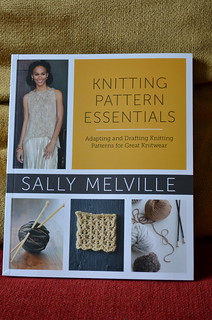First, the facts:
Title: Knitting Pattern Essentials: Adapting and Drafting Knitting Patterns for Great Knitwear
Author: Sally Melville
Published by: Potter Craft, 2013
Pages: 224
Type: Instructional, with patterns
Chapters:
1. Preparing to Draft
2. Basic Shapes
3. Shoulder Shaping, Back and Front Neck Shaping
4. Hem Alternatives
5. Side Shaping
6. Sleeve Alternatives
7. Cardigans
8. Fabrics, Finishes, and Fixes
9. Patterns
The In-Depth Look:
There are more and more books these days about how to design your own sweaters, but there are always niches left open, gaps to fill, and that’s what Sally Melville did here. She saw that there were plenty of books on design, but not on drafting and stepped forward to fill the need.
She writes in the introduction, “We don’t love what we don’t understand. As newer knitters, we often follow published patterns without question–patterns that may not be well written, patterns that may not be appropriate to our skill level, patterns for garments that bear no resemblance to the clothes we actually wear. We finish the garment … or not … and it looks okay … or not. In the latter case, we’re not quite sure what’s wrong but–without breaking stride–we’re off to the yarn shop for more yarn. (Knitters are unfailingly optimistic!)”
What follows is basically a detailed explanation on how to knit the shapes you want. Well, no, that sounds simplistic. What follows is an analysis of the different shapes that go into a sweater (body, sleeves, necklines, and so on). She provides a chart for what combinations work together, and then plunges into details on how to do, well, everything.
Not the knitting part, mind you. The book assumes you already know the basics of actually knitting a pattern. Nor does she discuss colors and drape and fibers … that, she says has been well covered elsewhere (specifically mentioning Deborah Newton’s excellent Designing Knitwear).
No, what she does here is tell you what you need to know to get from point A to point B.
She explains, “This is not a design book. Design is different from drafting, and this book is about the latter–the mechanics and support material that bring your vision to life. Design is about finding that vision–where to look for inspiration, how to choose yarns, what colors work together, how to envision stitch patterns in combination and so on. … Throughout the book, you are the designer, and my job is to offer the know-how that makes your design become a garment.”
Still not clear? Without wanting to frighten anyone, think back to the geometry you learned in high school–the angles of triangles and steepness of curves and how there were certain mathematical requirements to make them work. (“If the slope of line A is half that of line B, how steep will line C be?”) Or, think about the pixels that make up your computer screen–when you zoom in ultra-close, things get “pixelated” and curves suddenly become choppy as you see the building blocks that go into each one … much like a series of knitting stitches being decreased at an armhole.
Now, if you’ve got the vision of a fantastic sweater in your head–you’ve got the yarn and the colors and the stitch patterns all clear in your head, but math and spatial reasoning isn’t your strong suit–this is the kind of book you need. Sally Melville walks you through each step and all you need to do is plug in numbers. (Stitch gauge is this, row gauge is this, neck will be this wide at bottom, this wide at the top, and this deep … how and when do I increase?)
She says specifically, “You will need to ‘do the math’ to draft a pattern. I know some of you don’t love the subject of math, but here’s what I would say by way of encouragement. Read the following to make sure you understand basic terminology and symbols. Then read about fudging, so weird results don’t scare you. … Above all, know that with a positive mind-set, and moving as slowly as you need to, it will all become familiar and comfortable very soon–and you’ll wonder why you ever thought it mysterious!”
See? There’s a LOT of information in here, as she walks you through drafting a pattern from an existing sweater to start, and then letting your imagination go as you crunch the numbers for as many more as you want. (She even specifically says that if this means you never buy another of her patterns every again, she’s okay with that.) As a reward for learning/honing your new drafting skills, there are even 8 new patterns included in the book. All sweaters, because the book is devoted solely to drafting sweater patterns (not gloves, not hats, not shawls).
Really, it’s a wonderful book. Chock-full of information, presented in a helpful and appealing way. The tone is readable and pleasant (even when talking about math), and the information is top-notch.
This book can be found at Amazon.com.
Want to see bigger pictures? Click here.

This review copy was kindly donated by Potter Craft. Thank you!
Other posts for this author:


